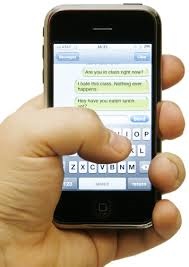Text Neck Pain – The Next Neck Pain Generation
We are experiencing an increase in neck pain from using phones. Years ago, it was holding a wired phone between the neck and shoulder. With the advent of headsets, this was remedied. However, with new wireless phones comes texting and constantly looking down at the phone, resulting in what is now called “text neck” and we are getting a whole new generation with text neck pain.
 Texting can truly be a pain in the neck. As you look forward, the weight of the head is constantly being held by the neck muscles. The further down you look, the more stress the neck has to deal with. Add hours of texting and the neck muscles get very tight; overstretched in some areas and shortened in others. The muscles don’t get the right supply of oxygen and waste products build up. Joints and discs undergo additional stress, pressure and loss of nutritional lubrication, resulting in stresses leading to early degeneration and arthritis, as the inflammation builds.
Texting can truly be a pain in the neck. As you look forward, the weight of the head is constantly being held by the neck muscles. The further down you look, the more stress the neck has to deal with. Add hours of texting and the neck muscles get very tight; overstretched in some areas and shortened in others. The muscles don’t get the right supply of oxygen and waste products build up. Joints and discs undergo additional stress, pressure and loss of nutritional lubrication, resulting in stresses leading to early degeneration and arthritis, as the inflammation builds.
Having the head forward, down, and just hanging there can lead to headaches from stressed neck structures as well as eye fatigue. So, with this great new form of communication – texting on smart phones, comes a hunched over posture and the aches and pains that go with it. Rounded shoulders hanging forward stretch the muscles and balance is lost between the neck and shoulders, further aggravating the condition.
In addition to text neck pain, individuals also experience elbow and thumb pain. This is from pressure and inflammation of tendons, leading to the new tennis elbow or carpal tunnel syndrome. I guess we can call this text elbow and text wrist, because most individuals are not aware what is causing the problem.
You can see a patient sitting on a therapy table with a heating pad on their neck. They are supposed to be lying down, but when you check up on them, they are sitting there using their smart phones and texting! Hunched over, head forward and down, tapping away in this iPosture. I’m treating you for neck pain and you are hurting your neck during treatment! Well, from now on a sign on the therapy room door, “No Cell Phones!” Too bad they are texting while walking into the therapy room and not reading the sign!
 Text neck posture is easy to see just about anywhere. At a college campus, stores, waiting rooms, adults, kids, teenagers, seniors…. perhaps we are all guilty of this. Want to see it gone wild? Go to a cell phone store! This new form of communication is now ingrained into our culture, and with the benefits of smart phones are impressive, we are going to have to deal with a new generation of musculoskeletal problems with text neck pain. It’s the same problem, just a new name and a great increase in frequency and incidence. So, now instead of poor posture, we can give a name to the problem that might help in recognition of it “iPosture”. But I like text neck better, so it is not a new confusing term related to the eyes!
Text neck posture is easy to see just about anywhere. At a college campus, stores, waiting rooms, adults, kids, teenagers, seniors…. perhaps we are all guilty of this. Want to see it gone wild? Go to a cell phone store! This new form of communication is now ingrained into our culture, and with the benefits of smart phones are impressive, we are going to have to deal with a new generation of musculoskeletal problems with text neck pain. It’s the same problem, just a new name and a great increase in frequency and incidence. So, now instead of poor posture, we can give a name to the problem that might help in recognition of it “iPosture”. But I like text neck better, so it is not a new confusing term related to the eyes!
So, now this iPosture results in a syndrome called text neck pain. There is an abundance of scientific literature indicating pain syndromes from computer workers and assembly line workers that look down a lot. Now we are compacting this posture in a more hunched over position, like a turtle, the iPosture. I guess as devices get smaller and smaller, we will have to evolve smaller thumbs. We will hunch over and compact so much, we will turn into diamonds!
It’s not surprising the term text neck originated from a chiropractic patient. Maybe chiropractors are behind this? No, no conspiracy. I’m a chiropractor and I would know. Although, giving out free smart phones might increase business, there’s plenty of reasons for neck pain these days. There has been a gradual increase in ergonomic awareness, including office and home furniture design, however, hand someone a smart phone, and it all goes out the window!
It’s not easy seeing an increase in neck pain in teenagers. Mom brings in her son for treatment. I am reviewing x-rays, showing a reverse in the normal curve of the neck. Moms looks at me and I point to her son sitting there texting on his smart phone! A picture was worth a thousand words. Biomechanics and neuromuscular anatomy is one thing, your kid hunched over his smart phone texting away is another. So, when I say he’s got text neck pain, Mom understands.
 There is a new generation of texters that will suffer from text neck pain and long term consequences if we don’t do something about it. While I am a somewhat clumsy texter, I see kids texting so fast and so intently, I am amazed! Texting has become a way of life.
There is a new generation of texters that will suffer from text neck pain and long term consequences if we don’t do something about it. While I am a somewhat clumsy texter, I see kids texting so fast and so intently, I am amazed! Texting has become a way of life.
It’s not going away. I leave my office door open and, after lecturing a patient on the dangers of text neck and the iPosture, they see me sitting at my desk texting, and not very well. Take a break. Look at a distant object to rest the eyes. Get up and stretch. Stretch the neck, upper back and shoulders as well as the hands. Do some strengthening exercises for the neck and shoulders. Try to sit with better posture and have more awareness about it. Keep your chin up! Try to bring your head over your shoulders. Hold the phone at an angle, bringing the phone closer instead of letting the phone drag you out. Squeeze your shoulder blades together, hold for a bit, then relax. Repeat this.
So, we try to educate about ways to make a healthier texter. This needs to be done early and reinforced in creative ways, by parents and educators alike. Texting is obviously not going away, but lets try to help prevent the future generations from suffering the ill effects of iPosture and text neck pain.
- A 2019 study in the Journal of Orthopaedic Science found a higher prevalence and probability of developing both back and neck pain in adolescents who used a mobile phone more than 10 hours per week. The authors also found increased low back pain in association with older students and who sit with a spine in a wrong position.
- A 2020 study in Applied Ergonomics found among adolescents smartphone/tablet use neck, shoulder and low symptoms more related to poor ergonomic use than duration of use. They did not find a correlation with visual symptoms.

- A 2020 study in Ergonomics found that when using a smartphone, the most harmful postures were with minimum screen display brightness, and the ambient lighting was compared to a sunny day. Compensation for this caused poor posture and indicated increased risks of developing musculoskeletal disorders.
- A 2020 study in the journal Spine indicates using a smartphone while walking can cause a larger muscular load to the lumbar spine erector spinae muscles than that of normal walking and be a risk factor for low back problems.
- A 2020 study in the journal Work found 30 minutes of texting produced significant neck and shoulder pain in healthy young adults and was associated with degradation of muscle performance. It was noted that the use of kinesio tape to support the muscles decreased pain and related electromyography findings. This form of taping can be a quick fix for those experiencing pain.
- A 2020 study in Applied Ergonomics found patterns of smartphone/tablet use (bout length, certain types of activities, multitasking) can pose a prospective risk for musculoskeletal symptoms in adolescents. Smartphone use was associated with neck/shoulder and low back symptoms; tablet use was also associated with arm symptoms.
- A 2021 study in the Korean Journal of Pain found that smartphone addiction was correlated with duration of use on a typical day, duration of owning a smartphone, and musculoskeletal pain in the neck, wrists/hands, shoulders, and upper back.
- A 2021 study in Ergonomics found that as the neck flexion angle increased, the gravitational force of the neck increased significantly. The erector spinae muscle activity significantly increased, while the upper trapezius decreased. For texting while standing, the neck should maintain a neutral or 0° flexion to alleviate neck discomfort.

- A 2021 report in the International Journal of Environmental Research and Public Health indicates, “During the last few years, a growing reporting of data is showing that the “text neck syndrome” might be considered as an emerging 21st-century syndrome. This clinical condition refers to the onset of cervical spinal degeneration that results from the repeated stress of frequent forward head flexion while we look down at the screens of mobile devices and while we “text” for long periods of time”
The authors also indicate, “It has been reported that the cumulative effects of this exposure reach alarming results of an excess stress on the cervical spine area, ranging from an average of 1825 to 2555 h a year”. In their study they found “Findings support the contention that an appropriate approach for an early diagnosis and treatment is crucial to properly evaluate this emerging issue worldwide in children and adolescents who spend a lot of time watching smartphones and computers…”
- A 2021 study indicates 66% of participants developed neck pain during 30 minutes of smartphone use with sustained neck flexion. The most common symptom description was “aching.” Those with pain had a lower cervical extensor test duration after 30 minutes of smartphone use than before use.
- A 2022 study in the International Journal of Environmental Research and Public Health indicates university students have the highest smartphone use/addiction and coincides with a rising number in instances of neck pain. The resulting increase in neck flexion tends to increase can affect the spinal cord by the direct and indirect mechanisms which lead to cervical myelopathy. Those with prolonged smartphone (9 or more hours per day) was associated with at least one positive clinical myelopathic sign. The authors relate smartphone using university students need to keep their duration of use to less than 9 hours per day.
- A 2022 study in Cranio found smartphone addiction and the effects of cervical superficial muscles are related to the performance of the deep cervical flexors in young people. Using smartphones causes impaired joint position sense, decreased deep flexor activity, and forward head posture.
- A 2023 study in the journal Work found relations between the prolonged use of mobile phones and pain in neck/upper back, hands, and symptoms of cubital syndrome (which can cause numbness or tingling in the small fingers, forearm, and/or weakness in the hand.) There was an association between smaller hand to phone ratio and pain in neck, upper back and shoulders. Indicating an association between mobile phone use and self-reported pain.

